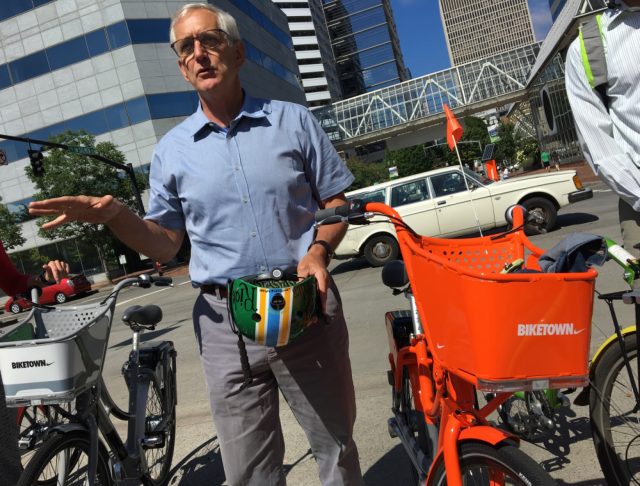
(Photo: J. Maus/BikePortland)
The City of Portland will take down the “Better Naito” project this Sunday night, whether it returns as a permanent bikeway and walkway someday is up to us. That was the message Mayor Charlie Hales gave a group of advocates, city staff, and agency representatives this morning.
This project has been a dream of Hales for almost two years.
“What if we just took that east lane on Naito and went ahead and made it into a bikeway?” he proclaimed while on a bike ride in August 2014. Then the nonprofit Better Block PDX made his wish a reality in 2015 when they installed “Better Naito” — a lane marked off by traffic cones and DIY signage that created dedicated space for biking and walking. That multi-week demonstration was so successful that the City of Portland brought it back for three months this year.
While Portlanders pedaled and walked freely in their new safe zone on adjacent to Waterfront Park, Hales surprised everyone with an attempt last May to make it permanent. He requested $1.5 million for the project out of his budget — money that would have come from a controversial tax hike on businesses. That wasn’t the right strategy to fund Better Naito and the project went nowhere.
Now, with the window closing on his Mayoral tenure, Hales has a new plan to fund what could be the most important piece of his cycling legacy. The current Better Naito pilot project ends on July 31st (this Sunday). With that date near, Hales called a special meeting this morning to proudly announce that he remains fully supportive of making the Better Naito changes permanent.
After riding a Biketown bike share bike with several dozen advocates, city staff, and other agency representatives, Hales gathered the group at the new Ankeny Plaza and laid out his case for the $1.5 million project. He said as Portland grows quickly in the coming years we need to fit more people on our streets. Here’s how the mayor is making the case for Better Naito:
“Another reason we need to think about that evolution from 630,000 to 850,000 people… We have a very successful promenade in Waterfront Park. We have activities out there all summer long and we have a lot of people that commute through there on bike or on foot. There’s not enough space. We need a sidewalk on this side of Naito for pedestrians. We need a permanent bikeway where we now have a temporary bikeway. It’s for capacity reasons. That’s the agenda here: Where can we create additional, non-auto capacity in ways that work? To me, Better Naito is a sterling example of that. So we have this opportunity I hope this year to make that project permanent.
I’m glad we got to be here together with the temporary version of it and I look forward to all of us riding it as a permanent version.”
Advertisement
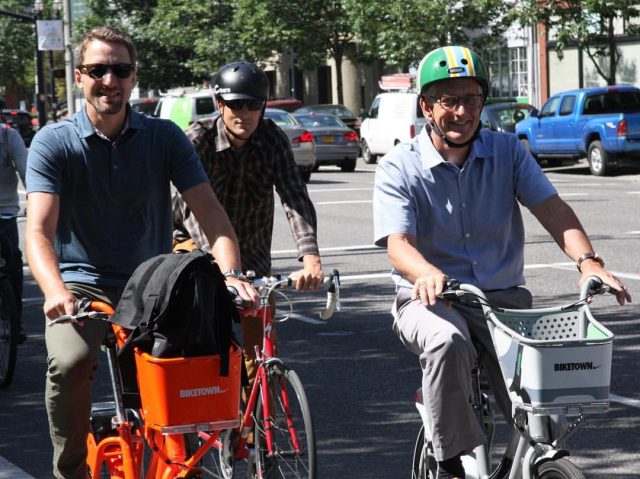
(Photo: City of Portland)
Hales and his team plan to hammer out details of a proposal in time for the request to be considered at the city’s fall budget monitoring process (known as the “BuMP”) in October. That’s when the city will take a look at how its collected tax revenue stacks up against existing expenses. Since the economy is strong, Hales thinks it’s a “pretty safe bet” there will be extra funds to invest back into the city.
This means that while there’s strong momentum for Better Naito, there’s still a political lift ahead. It might be worth noting that representatives from Commissioner Steve Novick and Commissioner Dan Saltzman’s office were on today’s ride. That’s three of five votes right there. But even if we assume those two are supportive, there’s no telling how the vote will go if/when it happens.
If you have opinions about the changes on Naito, email them to naitoparkway@portlandoregon.gov and send a copy to the five members of Council: mayorhales@portlandoregon.gov, nick@portlandoregon.gov, amanda@portlandoregon.gov, novick@portlandoregon.gov and dan@portlandoregon.gov.
The public debate has already begun. Here are a few selected tweet from the last few hours:
I'm not stopping until we save #BetterNaito and I hope @MayorPDX @NovickOR @CommishFish @dansaltzman @AmandaFritzRN are paying attention.
— PJ wants Trump to pay for his crimes (@__P__J) July 26, 2016
@tedwheeler I hope you'll consider re-opening the closed lane on Naito to cars once you take office
— Casey Holdahl (@CHold) July 26, 2016
Terrific news for #OTCT and Portland in general. Our neighborhood continues to transform for the Better. https://t.co/msvLaO5aRw
— Old Town Chinatown (@OTCTPDX) July 26, 2016
And Mayor Hales himself has already gone on the offensive. He posted a call for support of the project on his Facebook page today.
Regardless of feedback, the city says they plan to take down the existing cones at the end of Sunday. That means Naito will return to its previous alignment with two standard lanes, an unprotected bike lane, and no space for walking. PBOT spokesman Dylan Rivera said in an interview this morning that PBOT will collect data after Better Naito comes down in order to compare and contrast traffic volumes and travel times. Stay tuned for results of their analysis.
— Jonathan Maus, (503) 706-8804 – jonathan@bikeportland.org
Our work is supported by subscribers. Please become one today.


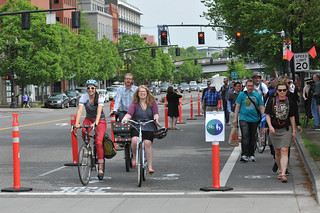

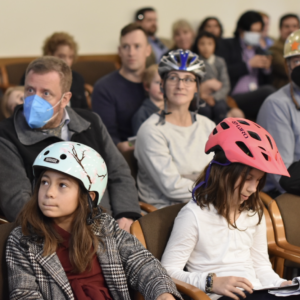
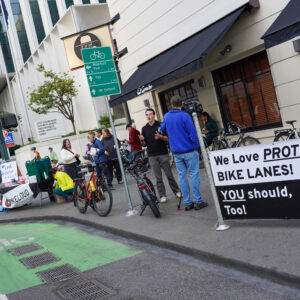
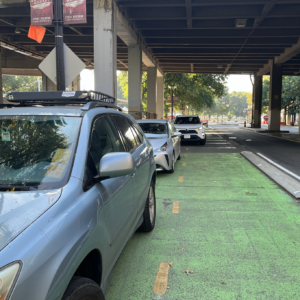
Thanks for reading.
BikePortland has served this community with independent community journalism since 2005. We rely on subscriptions from readers like you to survive. Your financial support is vital in keeping this valuable resource alive and well.
Please subscribe today to strengthen and expand our work.
So it’s still going to come down, but next time it should be permanent? (if there is a next time?)
Here’s part of what I wrote in support of it last night:
Too bad our weak-mayor system makes the Mayor’s “support” meaningless. Why wasn’t this proposal made last year? Or at the beginning of the summer? Why wait until the bike lane is removed to “work out a plan”? Why not just leave the temporary bike lane up while the plan is hashed out? Will the city again spend a year of public outreach that drains the project’s budget? This whole process screams of reactionary dysfunction.
That being said, I look forward to the permanent design (which I still say ditch the two-way design for a cycle track on each side of the street). This has been a long time coming, and while the opportunity to fast-track the project has come and went, we can at least settle for the slow-track.
i hear your frustration Adam. One reason the current temporary stuff has to come down is because of politics. And I agree with them. Here’s the deal: PBOT and City Hall did a huge thing by working closely with Better Block and extending this “pilot project” to 3 months this year. One way they are able to do that is by promising the powers-that-be (and the haters) that “it’s only temporary, it’ll come down on July 31st”. So.. If they don’t stay true to that promise, they lose credibility and their ability to do similar pilot projects in the future gets weakened severely. I wish it was staying up too but I’m glad they’re staying true to their word. This stuff brings out backlash and disagreement, so PBOT has to be careful to maintain credibility.
And yes, governments and politics is pretty much inherently reactionary and dysfunctional sometimes. If you just expect it, embrace it, and figure out how to make the best of it, it makes it a lot easier to deal with.
Sure, but by taking it down, then putting it back up, aren’t we doomed to repeat the same backlash over and over again? If it’s made permanent, we only have to endure it once. If the city breaks their promise and leaves Better Naito in place, people will be upset. But, if the city removes Better Naito, then puts it back later, people will also be upset. The people who get upset at things like this, mostly just don’t like change, so why are we changing things back and forth constantly?
There has to be a better approach. IMO, the city has already messed up by saying it will be taken down in the first place. What they should have said was “This is a trial project, and if it is a success, we will make it permanent. If not, we can easily remove it.” This is what JSK did in NYC – we need to be framing the projects thusly, rather than calling them temporary as if they are simply an annoyance for drivers that will eventually just go away.
This is my concern too, and I’ve said it all along about the “temporary” projects.
This “temporary” project worked on me. I thought it was nuts, but after a chance to really check it out, I’d like to see it tweaked a bit and made permanent. I’m personally not very interested in the effect on mv traffic, but in hindsight it would have been great to study the difference it made in pedestrian / bike interaction on the river walkway (word choice intentional). I was actually behind a person on a bike last night, at 5:05 PM in the riverfront park, who was travelling more slowly than I meant to go. Kind of refreshing in a way. Getting strafed by hellbent bike jockeys does get old.
if they left it up it wouldn’t be the first, or last, transportation promise that’s been broken…
A “strong” mayor is great as long as the mayor does what you want. Would you still support a strong-mayor system if the mayor were looking to increase auto-capacity of the streets?
A government with checks-and-balances may be frustrating at times, but it is far better than the alternative.
A strong mayor still needs support of City Council.
So what powers do you want the mayor to have that he doesn’t today?
Leadership? Executive power? Currently, he functions the same as the other councilpersons, other than he gets to assign bureaus. “Mayor” is essentially an honorary title. You can read all about it on Wikipedia.
I know how our government works. Hales could be in charge of any bureaus he wants, so he has more power than any other councilor. And leadership is a function of the person, not the office. I’m still unclear what you want to change.
How about a geographically-representative City Council, rather than one that represents the needs of the SW hills?
Why is geographic diversity more important than, say, racial diversity? Or political diversity? Or gender diversity? Geographic diversity is easy, but superficial.
Well for one, you can’t vote by race or gender. You can vote by geography though, and geography is closely tied to race, and economic status. Getting someone who represents the needs of East Portland on city council would be a huge start.
Gender and race representation is important too, but must be accomplished other ways. Bringing organizations that represent various groups to the table early is a good approach. Getting the money out of elections would help too – it’s ridiculous that it’s so expensive to run an effective political campaign. Smaller, more neighborhood-focused elections can help with that, as the candidate only has to focus on a smaller chunk of the city. I do think elections by district can go a long way towards helping with racial and economic representation.
how does geographic election or representation work with bureau assignment? Seems like little fiefdoms where one area gets the best of that bureau, while the others do without.
This reminds me of charlie hales’ bike path to Astoria. Sounds good, no action
except that the city has already constructed this bike path two different times, once for three whole months and the city has already funded it with staff time and resources. And the mayor has already proposed a $1.5 million project to city council once and is about to do it a second time. Also, the mayor just did a meeting and tour of the path where he extolled the virtues of the project in front of representatives from other city council offices. So. Very different than a bike path to Astoria!
Except Hales has no power to do anything outside of Portland. The path to Astoria is not his to build without getting other citys and countys and the state governments on board. There’s enough issues in Portland to keep the mayor busy, without bringing up a project that while a good idea, will require time and effort on his part that should be focused on Portland.
I urge everyone to get those emails out and make it so uncomfortable for the City Council to NOT get this done. You know that #BetterNaito gave you more than five minutes of easy riding. Please take five minutes out of your life and send an email!
Being “better” isn’t necessarily the same as being good. As much as I’ve ridden Better Naito lately, I won’t miss it. It’s still Naito, no matter how much you polish the thing.
Put a sidewalk on the east side of Naito. Create parallel bike routes nearby, and people who don’t like the “swift” 14MPH downtown pace can use the waterfront trail.
It’s stupid to finally close the Naito Gap only to abandon the rest of it.
It should not be an “either/or”, although most of the time it is.
Naito worked with the bike lane (I ride it every day year around). If keeping it is easy and cheap, great, but there are more pressing bike issues than this, in this city.
Getting on Naito from Barbur/south is a nightmare. This should be fixed first.
The waterfront is well taken care of in the bike department compared to the rest of the city. Spend the money and political capital in East Portland.
In fact, after the complete mess the mayor has made out of the Springwater, he owes that part of the city.
The investment in connecting from southbound Barbur makes more sense, has more leverage, when it connects to a little woonerf-lite strip of pavement that takes a person with bike all the way through downtown with no potentially fatal traffic conflicts, in a space where all they have to do is not hurt other people and pedal their bike. Pedestrians mill about? That’s called a Tuesday folks. That’s what pedestrians do. People with bikes pop a light once in a while? NBD actually. Welcome to Idaho. Fatal accidents vanishingly rare, really unfortunate serious injuries are headline news because ¡seldom! That was me on Thursday night nailing down the cones with a percussion cap hammer tool.
bogus handle of day: Carrying water for better Naito
northbound Barbur. Oops.
If people push for this at Council the way they pushed for Clinton diversion, I think this can happen.
If I’m coming to downtown from NW on Naito, I will not cross the street twice if a two-way facility is built on the east side. That’s why I support separate one-way facilities; otherwise I’ll have to continue using the skinny southbound lane and deal with the merge at the Morrison Bridge ramps which can be terrifying. Those ramps need to be relocated or demolished soon.
I hate those Morrison bridge ramps…
they need to decommission them and force people to use a different route… but since they’re an I-5 connector they’re not going anywhere until they get replaced with a more direct and ugly fly-over ramp…
I read this with mixed feelings. Hales is right in stating that the road needs a redesign because waterfront is being used as what’s best described a as a fairground.
I am not comfortable with that decision being taken as a given.
The better naito trial is not what I would go with, but I rarely agree with anyone around here.
As someone who rides its entire length almost every day, I’m not a fan of Better Naito. When the fairs are going in the summer, it’s a a practical method of dealing with spillover crowds. However, I find it considerably less safe than the normal arrangement and strongly prefer the winter time configuration.
Under Better Naito, a substantial percentage of cyclists ignore the stoplights in both directions, especially those traveling along Naito. It blows my mind that I haven’t yet seen peds/cyclists get t-boned or speared at speed. Riders on this stretch seem particularly bad about meandering all about the path representing a threat to those traveling the opposite way and a hindrance to those who prefer to move along.
As a temporary measure when the waterfront is crowded, I can accept Better Naito is the best option. But definitely not the rest of the time — if any permanent measures are implemented, a redesign is called for. I’ll take riding by cars any day over that mess — far more predictable and less dangerous IMO.
I also ride Naito everyday year round and share your sentiments. It felt far more dangerous with people running the stop lights and generally not paying attention. Each day as I turned north onto Naito from Stark I worried that I was about to get creamed. I also agree that as a temporary fix during festival season its fine but I’ll be glad to be back to the normal configuration. I’ve never felt I was in danger riding next to the auto lane. There are no conflicts other than the new connection at the Steel Bridge but I take a right and use the upper deck. If a permanent solution is implemented it should be buffered/protected bike lanes north and south.
I’m sure we’ll have some bike cops out there cajoling and doing some gentle traffic enforcement 😉
Still putting bikes in the street with no barrier between people and cars. A step forward? I think not.
A step forward would be to put bike lanes on fast moving roads that lack them entirely (particularly those that have no shoulder and butt into a curb) before redoing areas that are already good.
Sounds like Washington County.
I’d rather have fewer, better facilities than lots of watered down concessions to bikes.
That only benefits the few cyclists who live in those areas. If we really want to encourage cycling, it needs to be more accessible to a wider community. “Watered down” is a great way to describe a showcase infrastructure that only exists in a tiny oasis.
The more cyclists there are, the more willingness there will be to create bike facilities. The only reason bike facilities exist in first place is because enough people were already cycling that a reasonable case could be made.
I am under the impression that some people here have no clue what cycling was like before there was any cycling infrastructure — or what it still is like in so many areas.
Even minimal changes can make a HUGE difference and totally change the cycling experience.
Not everyone does short hops in the downtown where most the traffic is crawling anyway. Many never get anywhere near downtown and others have significant distances to cover. I might add that public transit options totally blow for most of these folks.
If you want to shift away from car culture and towards cycling, there need to be options that appeal to a group beyond the most dedicated if you’re not lucky enough to live in a tiny area.
That ‘short trip’ person you’re describing isn’t me. My commute is from around NW 160th/Hwy 26 to the Lloyd District.
The best features of this commute are the Hwy 26 MUP, the lowered speed limit through Washington Park (thank goodness it’s not 55mph here), the greenways near the Pearl, and the pedestrian path on the Steel bridge. These are the parts without bike lanes, and the ones I would be most likely to recommend to friends who want to start riding to work. I’m willing to go out of my way (and I do) to ride on these stretches of road.
The worst parts of my ride are the ones with bike lanes. I have short stints on Saltzman, Barnes, Cornell, and Canyon Ct, all of which I get off of at the soonest opportunity. Much prefer to ride on a 25mph road with no bike lane than a 45mph road with one.
185th Ave has a bike lane. I don’t think anyone would tell you that the existence of a bike lane there has inspired them to start riding.
I used to live near Murray and Walker before I was a regular rider. The bike lanes there never inspired me to start riding. In fact, feeling ‘boxed in’ by those roads discouraged me from leaving my neighborhood for a long time, and for about 6 months I only rode around my immediate neighborhood, or on side streets to the TV Rec Center, so I could ride around on the blacktop paths there.
More recently, the Waterhouse Trail nearby has inspired friends of ours to get their bikes dusted off so they could ride on it. Will that inspire them to start commuting on their bikes? Well, first they would have to get over their fear of riding in the bike lane on Bethany. The Waterhouse Trail, BTW, is not even that great — it’s too skinny, missing curb cuts, and is not complete yet, but it sees a lot of bike traffic, and seeing bikes elsewhere in Beaverton is a bit of a rarity.
NW/SW 185 is a damn tragedy. Driving a motor vehicle there (for my work) inspired fear and loathing. I wouldn’t go there on a bike for a bet. It’s where the more-lanes-for-cars folks want to take the world. Bike lanes? Ironic.
The current state of Naito is not better. I ride this stretch five days a week and I prefer sharing the road with auto traffic far more than your typical, oblivious, ear bud wearing, phone worshipping “person”. The pedestrian traffic does not function with any level of competence. Through in the mob mentality of Saturday Market and you have a mess. BTW, you folks still think Charlie was running the show…ha, funny stuff. If you are afraid to ride…take the bus.
If Better Naito becomes permanent, it needs to be a BIKE way and not a WALK way.
Pedestrians have plenty of room to walk in the park. That’s what the park is for. Some festivals may have to move their fencing over by 15-20 feet to stop blocking pedestrians
Pedestrians deserve a sidewalk on the east side of Naito.
They have one. It is 20 feet wide and has a great river view.
Repurposing this Naito space is asinine. Naito is an arterial road. It has high car traffic volumes. I think more could be done to keep everyone happy if 15 feet of the park was carved out for bikes and pedestrians, leaving Naito in tact (with a jersey barrier running the length). Everyone would have safe spaces, and very little of the bike hate would come if traffic volumes remained the same.
I hear (see) your point Ted. There is a difference between promoting multimodalism and actively retarding motor vehicle volumes. In the Naito case, all that would be required is allocating 10-15 feet of space (starting at the white bike line and extending into the park) to have pedestrian and bike access on the west side of the park. Making the West aspect of the park bike and pedestrian space would still maintain the park-like atmosphere. All that’s required is to decrease the space the festivals take up every summer. It would mean fewer beer vendors (darn), fewer drunken tourists, and fewer tilt a whirls. Left in tact would be the North bound lanes, so a ~20 mph tour along the river remains possilbe As is stands presently, the left turning vehicles congest the entire viaduct, preventing any throughput via car.
Where are there left-turning cars? The major queue I see is for Morrison Bridge (N Naito to E Morrison). There’s another onramp for that bridge. In fact, *all* of the bridges are accessible from roads other than Naito, and several bridges have zero ramps or partial ramps on Naito.
The other left turns are onto downtown streets, I assume. That’s traffic that, for the most part, could use an alternate route (eg drive north on 2nd and turn left from there).
It’s textbook induced demand- there are alternate routes, Naito is being used because it’s perceived as the best/fastest option.
Even Amsterdamn, Copenhagen, etc have arterial roads. They haven’t eliminated all of them. Inducing everyone onto 2nd Ave to access the bridge would not make 2nd Ave any nicer for bike and pedestrians. The Better Naito project isn’t an “either/or” argument, but it’s being treated as if it is.
I’m not sure your argument is helped by bringing up these cities. Along almost every arterial road…. is a physically separated bike path.
https://www.google.com/maps/@55.6785459,12.5857669,3a,75y,335.05h,79.02t/data=!3m6!1e1!3m4!1s7H24sZMQYzN6LITpmJ3A1Q!2e0!7i13312!8i6656!5m1!1e3!6m1!1e1?hl=en
Not advocating for no separated path, just for one that is in the park on the west side, leaving the car lanes intact.
On the internet, nobody knows you’re a car
“It has high car traffic volumes.” = that’s the problem with most of downtown…
we need less cars so we have more room for people…
take out a lane and people will adjust just like they always have…
nothing can be done to keep everyone happy…
Can’t we have a bit of green space without someone wanting to pave over it? Jesus…
Green space that gets destroyed once a year and has to be re-sodded, wasting water and money. Green space is great, however I would advocate for ripping out the grass from Waterfront Park and replacing it with something that is low-maintennence.
Hundreds of geese may beg to differ, eh? But Adam has a point here. The Parks Dept. rolls over the sod for anybody who wants to set up carny rides or pour drinks or shoot fireworks or whatever. Why not set up some rainwater absorbing landscape that doesn’t require constant energy-intensive renewal after every event? The festivals are going to take every inch of space available, so if you cut out a couple thousand square feet for them to unload instead of blocking a thoroughfare they will probably deal with it. How many different flavors of beer fest does Portland have anyway, if one of them falls into the sea, is our domain any less? The park is kinda big. There’s room for kids to play, frisbees, dogs, a middle-weight brewhaha, _and_ a concert. Did I mention a bikepath? There’s room for that too.
Don’t get me wrong. I like beer. I’d like them to close bloody I-405 for a beer fest. That would be something.
for 9 months out of the year, the grass/lawn along the riverfront absorbs stormwater and sequesters carbon. It is grown on sand which does require irrigation and fertilizer but this also creates a drainage layer for winter rains.
The City could use artificial turf or permeable pavers, but each have very high carbon foortprint and over zero to negative stormwater treatment value. With our mild climate and very long growing season, cool-season grasses are actively growing, transpiring, and absorbing water most of the year.
My concern with all of the festivals is the privatization of public space. I think this has gotten out of hand at the waterfront. This is the CIty’s front lawn and it should be maintained as a free, public space for the vast majority of the year, including the summer! Getting rid of some festivals would also reduce impacts to the lawns and , IMO, is a much more sustainable solution than replacing lawn with artificial turf or porous pavement.
As many others have pointed out: Better Naito is not better. I happily bike two blocks west and take the auto lane on 2nd. I feel like the only reason the bike advocates want this is because they see it as an easy victory. Too bad that it’s a victory that so few cyclists will find useful.
Please keep in mind that the current Better Naito is crap. We all know that. Better Block knows that. That’s the point. It’s a DIY, temporary, very low-budget thing that defines a space and creates a conversation. “The idea is temporary, the concept is permanent,” is what Better Block folks like to say. And in that regard it is doing a fantastic job IMO. How can you judge changes to Naito based on this current mash-up of traffic cones? I don’t think you can or that you should. When Better Naito is made permanent the city will spend $1.5 million on it and it will be vastly better than the few hundred bucks the current iteration costs.
1.5 mil for a wider bike lane where there is a 20′ wide MUP 100′ away?
Really?
That MUP is fine in winter but is closed off during festival season with limited access.
What would be better about it aside from aesthetics and a hard barrier — or is the real plan to do something totally different?
The reason Better Naito fails is because the way cyclists and peds behave in this space presents much bigger safety issues than the cars did. I get that some people don’t like to be close to cars. But there are nearby options, and that is not true for so much of this city so it seems more appropriate to direct resources there.
Kyle,
care to explain how you got to “…presents much bigger safety issues than the cars did…”
pedestrian and cyclist chances of dying if struck by a car at 30 mph is about 75%, while at 35 mph it is 90%. There is no way a pedestrian-cyclist crash on that facility comes even close to those risk factors.
Too much of the cycling I see on “Better Naito” is Darwin Award fodder and the people doing it are a threat to everyone, including themselves. If you read this thread, you’ll see I’m not the only one with this experience.
There is no doubt that odds of injury or death are way greater in a collision with a car than with another cyclist or a ped. But the best way to avoid injury/death is to not crash in first place.
I see really dangerous cycling behavior every time I ride there. But the physicality of that section makes riding with cars safe/easy which already play nice. So yes, I prefer my odds with the cars.
The answer to this Very Real Issue is to paint it, I don’t know, vermillion, and take down all signage and stripiness, and let people work it out. Pedestrians will, mostly, figure out that they are more comfortable over by the river. Pedestrians in charge of bikes will mostly keep right and avoid collisions which is something that humans on bikes are pretty strongly motivated to do. If bike riders have to drop it down a click or two that means that running Naito from Salmon to Everett will take another 32 seconds or so. That’s about how long you typically wait for the middle bank of elevators at the Big Pink. Can you stand it?
Perhaps somebody will recognize this idea which I stole: It’s called a woonerf. If it’s good for cars it’s just alright for bikes. Put a curb around it, I don’t care.
Oh my. (clutches pearls). I think you left out about 8 syllables Jonathan. ‘Pretty goddamn noble effort’ was what was omitted, and ‘crap’ doesn’t scan with that. Sorry to have to be the one to mention it.
Seconding what Jonathan said, and pointing out the 95% of potential riders are not comfortable taking the lane on 2nd. This project is clearly not for you.
That was brief which is commendable. I’m still trying to figure out what it meant. Second is awkward for bikes because they mix with vehicle traffic? Better Naito has no cars crossing it (excepting truck loading which is abnormal). How is it not a refuge, compared to 2nd Avenue?
Well, Nick Fish doesn’t sound like much of a fan of Better Naito, judging by today’s City Council hearing discussions:
https://youtu.be/56BYjU8jrk0?t=2h12m30s
I heard Nick Fish’s testimony differently. I thought he was advocating for adding cycling/pedestrian capacity without drastically reducing auto capacity (~50%) on Naito. He (and the council) support the Ankeny plaza. The main sticking point in the testimony is Ms. Fritz and whether or not the space is to become privatized.
IMO, the Better Broadway project was awesome because it still allowed 66% of the previous auto throughput. It wasn’t too big of a pill to swallow for the auto masses.
Perhaps the Better Naito Pilot, once made permanent, will function better for those driving. As it stands now, every one not accustomed to the project taps the brakes upon seeing the sea of orange and creeps down the road well below cycling speeds, further congesting the remaining one through auto lane. Perfect is the enemy of good.
My pseudo-wonk-ROW- engineering idea is to actually shrink the road ROW, extend the park with a curb 8′ beyond the existing curb (2-3 feet beyond the existing bike lane line). This would create a curbed 8 foot path N bound, with space for a sidewalk along the west edge of the park. The remaining lanes could then be narrowed, maintaining the existing auto capacity without alienating the majority of road users.
Do you assume that motor vehicle throughput is just some number, multiplied by the number of lanes? I don’t think it is that simple. NE Broadway traffic was slowed mostly because people were confused and resisting change, not just because there 2 lanes instead of 3. I’m reminded of the flap about N. Williams. I know people who still hate it and won’t ride a bike there. This is kind of funny because it’s actually working pretty well. It is now the fastest way for a person on a bike to get from Broadway/Williams to any point North of there.
My wife and I used to commute on the waterfront for 8 months, then shift to crossing the Burnside bridge because the path gets so congested in the dry months. The Better Naito project shows that a west side path is necessary as well as the path on the bank. It can be done with creative striping on Naito, and with a path on the west side of the Park, without creating 1000’s of bike haters who use that road to drive to work on.
Cut the Naito by half. Traffic will find somewhere else or people will find another mode.